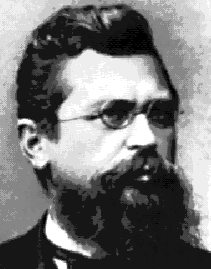Wilhelm Jordan (geodesist)
Wilhelm Jordan (born March 1, 1842 in Ellwangen , Württemberg ; † April 17, 1899 in Hanover ) was an important German geodesist . He founded the field of surveying (today geodesy and geoinformatics ) at the universities of Hanover and Karlsruhe and the multi-volume handbook of surveying .
education
Born as the son of the Judicial Councilor Wilhelm Friedrich Jordan and Julie born. Glock, he lost his parents when he was 10 years old. After high schools in Stuttgart, Ulm and Esslingen, he attended the courses for civil engineers and geometers ( field measurement ) as well as law and three humanities subjects at the Stuttgart Polytechnic from 1858 to 1863 and passed two service examinations to become a repetitionist and assistant at the Stuttgart Polytechnic. His dissertation was on trigonometric height measurement and its adjustment.
Professor and scientist
As early as 1868 he became a professor at the newly created Chair for Practical Geometry and Higher Geodesy at the Stuttgart Polytechnic, married Bertha Osiander, began building his first single-family house and, on behalf of the Royal Prussian Geodetic Institute, worked on the Rhineland degree measurement triangulation.
In 1871 he became Commissar in Baden at the Vienna Conference of European Degree Measurement in Vienna, in 1873 editor of the Zeitschrift für Vermessungswesen and taught in Karlsruhe until 1881 (until 1881), where his first paperback of practical geometry (1873) appeared in 1873. In 1874 he took part in Gerhard Rohlfs ' expedition to Libya , from which he brought back numerous photogrammetric and measuring table photos of oases.
Mentor and publicist of German geodesy
As a leading member of the German Geometer Association (now the German Association for Surveying ) founded in 1871, he played a key role in the restructuring of geodetic training in Germany in the 1870s. The first edition of his widespread logarithm tables and later geodetic auxiliary tables (13 in total) should also fall during this period.
In 1877 Jordan founded the calendar for surveying and cultural engineering , which provided an annual overview of the world of surveying and was published regularly until 1949 after his death. In 1880 he became an associate member of the Imperial Standard Calibration Commission for five years and worked on a 200 km long major project of precision leveling in Baden .
From 1881 he taught as a professor of geodesy and practical geometry at the Technical University in Hanover , but had to take a break the following year due to severe depression. In the years 1886 to 1894 he carried out the triangulation of the urban areas of Hanover and Linden . In Hanover he also began work on his main work, which is known today under the title Jordan-Eggert-Kneissl: Handbuch der Vermessungskunde . After his death, this work was continued by his successor in Hanover, Carl Reinhertz , and expanded to include further volumes by Otto Eggert . In 1896 he was elected a member of the Leopoldina .
Wilhelm Jordan's tomb, an obelisk , can be found in the Herrenhausen cemetery .
Gauss-Jordan algorithm
Wilhelm Jordan, along with Carl Friedrich Gauß , is the namesake of the Gauß-Jordan algorithm , which is sometimes ascribed to the French mathematician Camille Jordan in the literature . However, it is very likely that he is not the “inventor” of the step that extended the Gaussian algorithm , but only the one who brought it closer to his audience.
literature
- Walter Grossmann: Jordan, Wilhelm. In: New German Biography (NDB). Volume 10, Duncker & Humblot, Berlin 1974, ISBN 3-428-00191-5 , pp. 604 f. ( Digitized version ).
- Siegmund Günther: Jordan, Wilhelm . In: Allgemeine Deutsche Biographie (ADB). Volume 51, Duncker & Humblot, Leipzig 1906, pp. 476-479.
- C. Runge: Death notification , in: Astronomische Nachrichten , Vol. 149 (1899), p. 319 (obituary to W. Jordan).
- Paul Trommsdorff: The faculty of the Technical University of Hanover 1831-1931. Hanover, 1931, p. 67.
Web links
- Wilhelm Jordan: Handbook of surveying. First volume. 1888. (PDF; 18.5 MB)
- Wilhelm Jordan: Handbook of surveying. Second volume. 1888. (PDF; 28.1 MB)
- Wilhelm Jordan: Handbook of surveying. Third volume. 1890. (PDF; 40.6 MB)
- Literature by and about Wilhelm Jordan in the catalog of the German National Library
- Prof. Wilhelm Jordan, geodesist and "log table maker" (PDF; 2.5 MB)
- Publications by W. Jordan in the Astrophysics Data System
Individual evidence
- ^ Bernhard Heck, Norbert Rösch: The training of geodesists at the University of Karlsruhe (TH) in the course of time. Journal of geodesy, geoinformation and land management. 4/2009. Pp. 201-208
- ^ Gitta Kirchhefer: A walk through the Herrenhausen cemetery. Brochure with photos by Sergej Stoll and a numbered overview plan. Self-published, Hanover 2012.
- ^ Rainer Ansorge, Hans Joachim Oberle: Mathematics for Engineers, Volume 1. Wiley-VCH Verlag GmbH & Co. KGaA, Weinheim 2000, p. 110.
- ↑ Steven C. Althoen, Renate McLaughlin: Gauss-Jordan Reduction: A Brief History (English; PDF, 370 kB). In: American Mathematical Monthly, Vol. 94, 1987, pp. 130-142.
| personal data | |
|---|---|
| SURNAME | Jordan, Wilhelm |
| BRIEF DESCRIPTION | German geodesist and mathematician |
| DATE OF BIRTH | March 1, 1842 |
| PLACE OF BIRTH | Ellwangen , Württemberg |
| DATE OF DEATH | April 17, 1899 |
| Place of death | Hanover |
